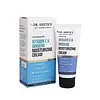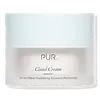What's inside
What's inside
 Key Ingredients
Key Ingredients

 Benefits
Benefits

 Concerns
Concerns

 Ingredients Side-by-side
Ingredients Side-by-side

Water
Skin ConditioningParaffinum Liquidum
EmollientTocopheryl Acetate
AntioxidantPropylene Glycol
HumectantSteareth-2
EmulsifyingCaprylic/Capric Triglyceride
MaskingCetyl Alcohol
EmollientSteareth-21
CleansingPEG-20
HumectantDimethicone
EmollientXylitylglucoside
HumectantAnhydroxylitol
HumectantXylitol
HumectantStearyl Alcohol
EmollientSodium Acrylates Copolymer
Lecithin
EmollientPhenoxyethanol
PreservativeTriethanolamine
BufferingBHT
AntioxidantPotassium Sorbate
PreservativeDisodium EDTA
Citric Acid
BufferingPanax Ginseng Root Extract
EmollientWater, Paraffinum Liquidum, Tocopheryl Acetate, Propylene Glycol, Steareth-2, Caprylic/Capric Triglyceride, Cetyl Alcohol, Steareth-21, PEG-20, Dimethicone, Xylitylglucoside, Anhydroxylitol, Xylitol, Stearyl Alcohol, Sodium Acrylates Copolymer, Lecithin, Phenoxyethanol, Triethanolamine, BHT, Potassium Sorbate, Disodium EDTA, Citric Acid, Panax Ginseng Root Extract
Water
Skin ConditioningGlycerin
HumectantPropylene Glycol
HumectantCyclopentasiloxane
EmollientDimethicone
EmollientDimethicone/PEG-10/15 Crosspolymer
Ceramide AP
Skin ConditioningRetinol
Skin ConditioningLactic Acid
BufferingButyrospermum Parkii Butter
Skin ConditioningSodium Starch Octenylsuccinate
AbsorbentScenedesmus Rubescens Extract
Skin ConditioningCamellia Sinensis Leaf Extract
AntimicrobialXylitylglucoside
HumectantAnhydroxylitol
HumectantXylitol
HumectantRubus Idaeus Fruit Extract
AstringentLavandula Angustifolia Flower/Leaf/Stem Extract
MaskingVaccinium Macrocarpon Seed Oil
Skin ConditioningPunica Granatum Seed Extract
Skin ConditioningCitrus Limon Peel Extract
EmollientCitrus Paradisi Peel Extract
PerfumingVanilla Planifolia Fruit Extract
Skin ConditioningAnanas Sativus Fruit Extract
Skin ConditioningPyrus Malus Fruit Extract
Skin ConditioningRosa Damascena Extract
MaskingVitis Vinifera Fruit Extract
Skin ConditioningAloe Barbadensis Leaf Juice
Skin ConditioningPEG-10 Dimethicone
Skin ConditioningTrimethylsiloxysilicate
EmollientCaprylic/Capric Triglyceride
MaskingPhenoxyethanol
PreservativeSodium Chloride
MaskingSodium Citrate
BufferingEthylhexylglycerin
Skin ConditioningDipropylene Glycol
HumectantTriethyl Citrate
MaskingTocopherol
AntioxidantWater, Glycerin, Propylene Glycol, Cyclopentasiloxane, Dimethicone, Dimethicone/PEG-10/15 Crosspolymer, Ceramide AP, Retinol, Lactic Acid, Butyrospermum Parkii Butter, Sodium Starch Octenylsuccinate, Scenedesmus Rubescens Extract, Camellia Sinensis Leaf Extract, Xylitylglucoside, Anhydroxylitol, Xylitol, Rubus Idaeus Fruit Extract, Lavandula Angustifolia Flower/Leaf/Stem Extract, Vaccinium Macrocarpon Seed Oil, Punica Granatum Seed Extract, Citrus Limon Peel Extract, Citrus Paradisi Peel Extract, Vanilla Planifolia Fruit Extract, Ananas Sativus Fruit Extract, Pyrus Malus Fruit Extract, Rosa Damascena Extract, Vitis Vinifera Fruit Extract, Aloe Barbadensis Leaf Juice, PEG-10 Dimethicone, Trimethylsiloxysilicate, Caprylic/Capric Triglyceride, Phenoxyethanol, Sodium Chloride, Sodium Citrate, Ethylhexylglycerin, Dipropylene Glycol, Triethyl Citrate, Tocopherol
Ingredients Explained
These ingredients are found in both products.
Ingredients higher up in an ingredient list are typically present in a larger amount.
This ingredient is created from dehydrating xylitol in acidic conditions. Xylitol is a famous sugar and humectant.
Much like its predecessor, anhydroxylitol is a humectant. Humectants attract and hold water to moisturize the skin.
This ingredient is most commonly found in a popular trio called Aquaxyl. Aquaxyl is made up of anhydroxylitol (24 - 34%), xylitylglucoside (35 - 50%), and xylitol (5 - 15%).
According to a manufacturer, Aquaxyl is known for a 3-D hydration concept and an anti-dehydration shield to reinforce the outer layer of skin.
This ingredient is often derived from plants such as wood and sugarcane.
Learn more about AnhydroxylitolThis ingredient is an emollient, solvent, and texture enhancer. It is considered a skin-softener by helping the skin prevent moisture loss.
It helps thicken a product's formula and makes it easier to spread by dissolving clumping compounds.
Caprylic Triglyceride is made by combining glycerin with coconut oil, forming a clear liquid.
While there is an assumption Caprylic Triglyceride can clog pores due to it being derived from coconut oil, there is no research supporting this.
Learn more about Caprylic/Capric TriglycerideDimethicone is a type of synthetic silicone created from natural materials such as quartz.
What it does:
Dimethicone comes in different viscosities:
Depending on the viscosity, dimethicone has different properties.
Ingredients lists don't always show which type is used, so we recommend reaching out to the brand if you have questions about the viscosity.
This ingredient is unlikely to cause irritation because it does not get absorbed into skin. However, people with silicone allergies should be careful about using this ingredient.
Note: Dimethicone may contribute to pilling. This is because it is not oil or water soluble, so pilling may occur when layered with products. When mixed with heavy oils in a formula, the outcome is also quite greasy.
Learn more about DimethiconePhenoxyethanol is a preservative that has germicide, antimicrobial, and aromatic properties. Studies show that phenoxyethanol can prevent microbial growth. By itself, it has a scent that is similar to that of a rose.
It's often used in formulations along with Caprylyl Glycol to preserve the shelf life of products.
Propylene Glycol is an odorless, colorless liquid. As a humectant, it helps skin retain moisture. It also aids in delivering active ingredients.
Another role of this ingredient is preventing a product from melting or freezing. Propylene glycol also adds antimicrobrial properties to a product, elongating product lifespan.
This ingredient is considered an organic alcohol and commonly added into both cosmetics and foods.
Those with sensitive skin or conditions may develop a rash when using this ingredient.
Learn more about Propylene GlycolWater. It's the most common cosmetic ingredient of all. You'll usually see it at the top of ingredient lists, meaning that it makes up the largest part of the product.
So why is it so popular? Water most often acts as a solvent - this means that it helps dissolve other ingredients into the formulation.
You'll also recognize water as that liquid we all need to stay alive. If you see this, drink a glass of water. Stay hydrated!
Learn more about WaterXylitol is a humectant and prebiotic. It can help with dry skin.
In studies, xylitol has been shown to improve dry skin. It decreased transepidermal water loss, or when water passes through the skin and evaporates. Xylitol also showed to help improve the biomechanical properties of the skin barrier.
The prebiotic property of xylitol may also help reinforce our skin's natural microbiome. Having a healthy microbiome prevents infection by bad bacteria and helps with hydration.
As a humectant, Xylitol helps draw moisture from both the air and from deeper skin layers. This helps keep skin hydrated.
Xylitol is a sugar alcohol and commonly used as a sugar substitute. It is naturally occurring in plants such as strawberries and pumpkin.
Learn more about XylitolXylitylglucoside is created from xylitol and glucose, two humectants.
Not surprisingly, this ingredient is also a humectant. It attracts and holds water in your skin, helping to maintain hydration.
This ingredient is most commonly found in a popular trio called Aquaxyl. Aquaxyl is made up of anhydroxylitol(24 - 34%), xylitylglucoside (35 - 50%), and xylitol (5 - 15%).
According to a manufacturer, Aquaxyl is known for a 3-D hydration concept and an anti-dehydration shield to reinforce the outer layer of skin.
Learn more about Xylitylglucoside